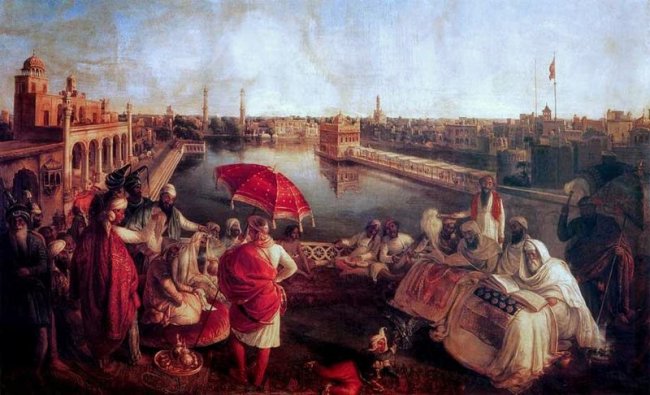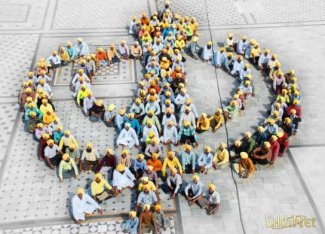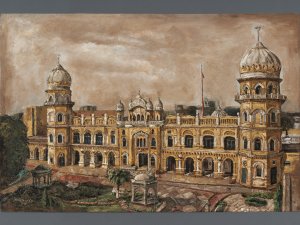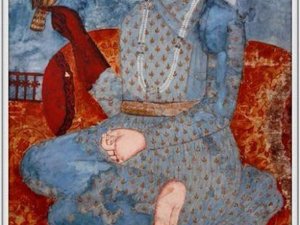Akal Takht is a 5 story building in front of Sri Harmandir Sahib or Darbar Sahib, in Amritsar. The building originally called ‘Akal Bunga’ was built by Guru Hargobind to cater to secular aspects of the Sikhie. The word Akal means timeless and Takht is a compound word comprising of Ta + kht, meaning base and line respectively. The word Takht also means throne in Persian. Thus, the Harmandir became the seat of spiritual power of the Sikh faith and the Akal Bunga (later Takht) became the central site of its temporal authority. Guru Hargobind also propounded the Miri (worldly authority) - Piri (spiritual eminence) concept at this site, to cater to the secular aspects of Sikhi. Earlier, the sole authority for the spiritual side had been vested in the Guru Granth Sahib by Guru Arjan Dev Ji, in Harimandir Sahib. Amongst the non-Sikhs, it is also popularly called as Golden Temple because of the gold plating. The height of the Akal Takht was deliberately kept under the height of Darbar Sahib, as the salute to the latter's spiritual eminence.
Inception
Guru Hargobind at age of 11, assumed the Guruship after the execution of the fifth Guru Arjan Dev Ji in Lahore. He started the construction of Akal Bunga in 1606 and it was completed in 1609. Guru Hargobind Ji laid the foundation of this structure, at the open space across the causeway to the Harmandir, which was a mound of soil from excavations of the sarovar. It was the site where Guru Hargobind Ji had played as a child. The mound became the embankment and with a raised platform of bricks on it, became the takht for Guru Ji to sit on. The raised platform was about ten to twelve feet in height. The two flags representing the temporal and spiritual were installed there.
The Piri Nishaan (flag) Sahib is hoisted higher, as a reminder of its spiritual eminence. Guru Ji’s daily routine was to start the day with a visit to Harmandir in the morning to participate in worship comprising of Aasaa De Vaar, Japji Sahib and Keertan. In the afternoon at the Akal Bunga he would meet and talk to those who came to pay him homage, or those seeking guidance to resolve their secular affairs. Soon it became an attractive option for resolution of secular affairs and not to look to courts in Delhi and Lahore to resolve those. Guru Ji’s resolution of disputes was fair, fast, and impartial. In the evening, he would return to Harmandir Sahib for prayers and singing of hymns, and then at night he and his followers would return to the Akal Bunga, to listen to martial songs of heroic deeds known as “Dhaddi Waran”.
Historical Capsule
Guru Sahib used to hold his darbar in front of Akal Bunga, administering justice like a sovereign ruler in court, awarding honors or punishments as decided by him, as well as accepting presents of horses and arms. These steps initiated by Guru Hargobind Sahib such as the wearing of two swords representing Miri-Piri, inception of Akal Bunga represented a major step in the new direction of getting the Sikhs into the fighting spirit. Besides, the issues that affected the Sikhs were discussed there, including political and military affairs. The ceremonial sendoff of Guru’s envoys and receiving of envoys from other states were held here. Guru Ji had realized that free growth of Sikhism will be impeded till arms were adopted for self-defense. Guru had appointed Bards Abdula and Natha as Dhaddies to narrate the songs of valor to inspire the Sikhs gathered there. The first Hukamnamma, issued from here by the Guru asked the Sikhs to bring horses and arms instead of money. Later, Guru Ji spent too much time outside Amritsar and the subsequent Gurus did not spend time in Amritsar, so there is lull of hukamnammas from Akal Bunga (Takht) for the guru period from 1615 to 1708, till the death of Guru Gobind Singh.
In 1721, five years after the torture and killing of Banda Bahadur, this Throne of the Immortal, re-emerges as the epicenter. After Banda’s execution, the control of Akal Takht was with Tat Khalsa. A dispute arose between Bandai Khalsa, the followers of Banda Bahadur and Tat Khalsa over the control of Akal Takht. Mata Sundri Ji (wife of Guru Gobind Singh) appointed Bhai Mani Singh, as the custodian of Akal Takht and gave him the responsibility of resolving the issues between two warring factions. Bhai Mani Singh, after deliberations with both the factions passed the Gurmatta to resolve the issue, thus the tradition of unanimous Gurmatta was born. The decision was arrived at after listening to all involved parties, arriving at a consensus in accordance with Gurbani teachings, in the presence of Sri Guru Granth Sahib. Malcolm has described the procedure for adopting Gurmatta in his book “Sikhs Sketch”. The institution of Gurmatta has always helped Sikhs at the time of calamity. From that time onwards the tradition of such decision making continued with 2 annual conclaves during Diwali and Vaisakhi.
During the Sarbatt Khalsa in 1733, after the offer of assuming Nawabship was spurned by the prominent leaders, it was finally offered to Kapur Singh looking at his spirit of service. He was quite reluctant upon assuming the leadership role, as he was content with being just a commoner. Those were days of challenging period, when even the survival of the Sikhs was at stake, the consensus emerged under the guidance of Hukamnamma from Guru Granth Sahib and Nawab Kapur Singh was impressed upon to accept the position of eminence. That was a turning point of Sikhs from existential crisis to becoming the rulers and masters of their land. He led the Sikhs with humility and guided by Gurbani, drawing from history, and never acting unilaterally, while striving for majority consensus.
He knew that any leader's support base is in the public. His actions and his strength of character as a leader endeared him to the masses. His empathy in helping the poor and punishing the oppressors, further catapulted his public standing. He ensured equality and secularism was the mantra followed by his associates. He did not harm anyone on the basis of religion, but punished exploiters of wrong deeds. He did not spare the wrongdoer and punished harshly to teach others a lesson and build confidence in the general public. He had an advisory council of ten Sardars, who in turn were leaders of their own Misls. The eleventh Singhapuria Misl, was directly under his command. Thus, he instilled a democratic and federal structure of government. Despite being the supreme commander, he always considered himself as only one amongst the many illustrious sons of the Guru and ever remained very humble.
In 1756 Ahmed Shah Durrani attacked India and while returning back from Delhi in 1757 his loot was plundered by Sikhs. He took his frustration out by having the Akal Takht and Darbar Sahib demolished and filled the sarover. In November 1760, the Sikhs again assembled before the Akal Takht and declared themselves as Sarbatt Khalsa, a Sikh theo-political voice of the centralized consciousness and will of the people, which resolved to take possession of Lahore, the seat of Punjab Government.
Later, even during the rule of Maharaja Ranjit Singh, their autonomy over Darbar Sahib Complex including Akal Takht prevailed. The arrangement continued during the British Raj from 1850. That arrangement broke down during the Jallianwala Bagh massacre in 1919 by the British. The Sikhs rose against that move by starting the Akali movement and British eventually handed over the possession back to the democratically elected body of the Sikhs called Shromani Gurudwara Parbandak Committee (SGPC). The formation of SGPC gave a new twist on what constituted as Sarbatt Khalsa as the elected body was projected as the representative body of the entire Sikh Brotherhood. This new arrangement changed the way the community decisions were made and the way Jathedars were selected.
Changes in Twentieth Century
There were significant changes taking place at the society level, because of the following major developments:
-
Two World Wars
-
Newer modes of transportation – such as automobiles, railways, aircraft etc.
-
Partition of Punjab at the time of Independence of India in 1947
-
Religious killing and Migration of Sikh population from West Punjab to rest of India
-
Formation of Punjabi Suba and division of East Punjab into 3 states
-
Declaration of Emergency in 1971
-
Migration of Sikh population to the western countries looking for economic opportunities
-
Attack on the Akal Takht and 43 other historical Gurudwaras in June 1984 dubbed Operation Blue Star
-
Assassination of Indira Gandhi and orchestrated revenge killings of Sikhs
As a result of all these events, there has been a significant realignment in the distribution of Sikh population around the world. Thus the SGPC being the representative body of Sikhs, managing historical shrines in three states Punjab, Haryana and Himachal Pradesh does not hold much water anymore. Further, with decisions and appointments of Jathedars were being made in a pre-mediated manner by the leader of the political party, claiming to be the representative body of Sikhs, has eroded the faith in the authority, institution and the credibility of said appointed leaders.
The panthic decisions, punishments, expulsions and pardons made by so called leaders without any input from masses or intelligentsia, with the Jathedars acting in random further widened the disconnect and heightened the chasm. Jathedars without any grassroots base, acting as mere rubberstampers for the kingpins, did not help the situation, but simply added to credibility deficiency. These institutional deficiencies need to be addressed to restore the position of pre-eminence of Akal Takht by involving the faithful at grassroots level.
Emerging Challenges
Besides the challenges from the last century, a whole new slew of ground reality of emerging challenges is brewing. The Internet, in the last thirty years, has made the world totally different from the world of the past. While the internet was transforming the world we live in, the Covid-19 pandemic turned the whole world upside down. The lockdowns because of pandemic extending even to places of worship, the travel restrictions have shaped new life realities that are becoming cataclysmic in nature. The new world has changed the way we work, pray, shop, celebrate events, take vacations or even hold religious gatherings. These extended lockdowns have resulted in mushrooming of virtual events to fill the void, and provide for spiritual cum emotional needs of the community. Even the way children’s education is being imparted, or play has been equivocally transformed. Now, the new world reality post Covid-19 pandemic is shaping out to be different, not just from the past historical world we learnt about from books, but even the world we lived in the past.
Future Possibilities and Relevance
The challenges being faced by the community are to bring the community back in alignment with its central rallying point, the Akal Takht. The challenges include staying focused on the issues related to wider interests of the community at large, and the cause of freedom that it originally espoused. Our congregational prayer “Ardas” espouses for the protection welfare of Sikhs everywhere, and spiritual ascendancy with Almighty’s Will. These words of prayers will yield positive results when we all align our thought process, actions and synergize our energies. The impact of individual efforts vs aligned, cohesive prayer of the community at large from the sanctified highest throne of the Almighty cannot be compared. History is the proof and we need to emulate it by a course correction from our present approach. The new, changed world reality may be beaconing to us as an opportunity to adopt the much needed course correction. The pandemic has bolstered religious faith, family and community connections.
The virtual meeting technology platforms are pointing to the new direction. We are already seeing some basic application of these technological platforms in starting virtual Gurmat Learning Groups, Vichaar webinars, world Intellectuals conference, kirtan programs, Guru Granth Sahib Santhiya classes, Guru Granth Sahib /Sukhmani Sahib virtual paath groups are sprouting all around. These theme driven events are potent of things to come. We need to take these nascent efforts and cascade them to a much higher scale to make it a unified voice of the faithful. The clear writing on the things to come is now not on the walls but on the computer screen. The population dispersion and resulting diversity that evolved as a result of migration and conversions into Sikhi faith, along with technical evolutions have made adapting to new world reality necessary and feasible.
In future, the virtual gathering will gain significant share from the in -person gathering model. This is going to be a challenge as well as an opportunity. As those disillusioned with the existing arrangements clamoring for reforms, have a possibility of making this new reality. In this virtual conclave, all Sikhs from any corner of the world can participate and join in the deliberations. This new world reality can enable Sikhs to emerge from the present crossroads, as the Sikhs did in the 1700s.
Conclusion
If the Sikhs from around the world can make this vision a new reality, then Sikhs would have reasserted the significant role of Akal Takht. The gaps of physical distances have been replaced with virtual connectivity where the work on alignment of thought process, consensus building can take place 24*7 uninterrupted. These developments have put the state, national and international borders constraints irrelevant for exchange of ideas and consensus building. Now the ideas of welfare of all (Sarbat da bhala) can be shared openly across nations, nationalities, time zones, with fewer censorship restraints and political control. The computer screen is going to become a glue to join the faithful or to unleash schism. This quantum jump can transform the existing lack of faith along with feeling of the disillusionment in the institution can be rectified. This can result in reestablishment of the epicenter with the suitable leader at the helm.
The glorious days of Akal Takht with its vibrancy, transparency, independence, more inclusive and representative culture can be our reality again. We need to learn from history, see how those skills can be implemented under present circumstances. A humble and technologically savvy leader at the helm, along with federal structure and assisted equally committed second tier leadership can unite the faithful by his forthright leadership.
In Guru Hargobind’s vision, the Akal Takht was a symbol of service and sacrifice and the same relevance for the present and future generation needs to be invoked if it has to become as relevant as it was in Guru’s eyes and his times. Our history is the indicator of the collective suffering during the invasions and how we could rise from ashes and create power then. Let us make that history our inspiration, guide us to overcome the challenges in the twenty-first century digital world. The study of Nawab KApur Singh’s life and the strategies adopted by this humble Sikh can provide insight on arriving at consensus building and community nurturing. Then their rag-tag, scattered bands were transformed into a homogenous organization. Today, we find ourselves in a similar scattered state; let us transform it learning from history. In the new world reality our solution will have a decentralized structure with local autonomy to address local challenges, coupled with a unified front for the common global issues. This two-pronged template needs foresight and astute leadership to execute it. Besides, technology with its potential for misuse is going to throw its own challenges. The structure that is created will have to have strong safeguards against those challenges plus means to quickly respond to any new scenario unfolding.
References:
-
Singh, Teja & Singh, Ganda. A short History of Sikhs. Punjabi University, Patiala (1994)
-
Singh, Dr. Santokh. The Guru’s Word & Illustrated Sikh History. Spiritual Awakening Studies, Princeton, ON (2000)
-
Singh, Kapur. The Golden Temple: Its Theo-Political Status. Dharam Parchar Committee (1995)
-
Dilgeer, Harjinder Singh. The Akal Takht. Punjabi Book Company (1980)
-
Gandhi, Surjit Singh. History of the Sikh Gurus (A Comprehensive Study). Gur Das Kapur and Sons. Delhi (1978)















